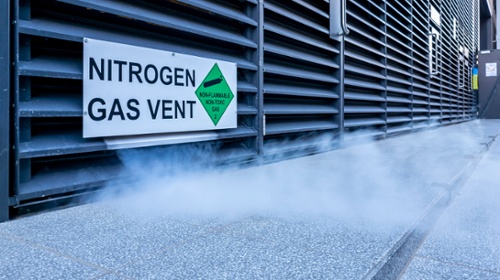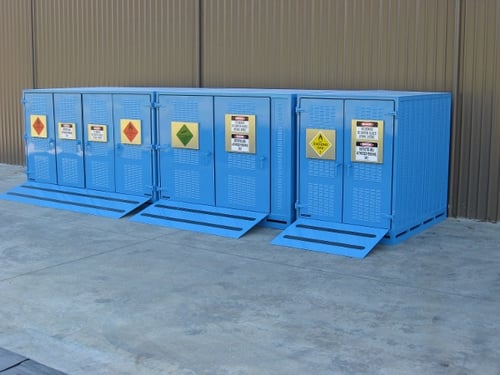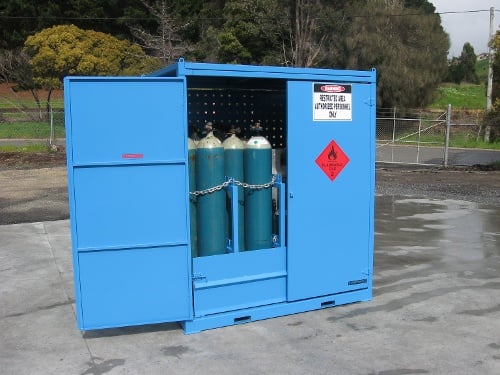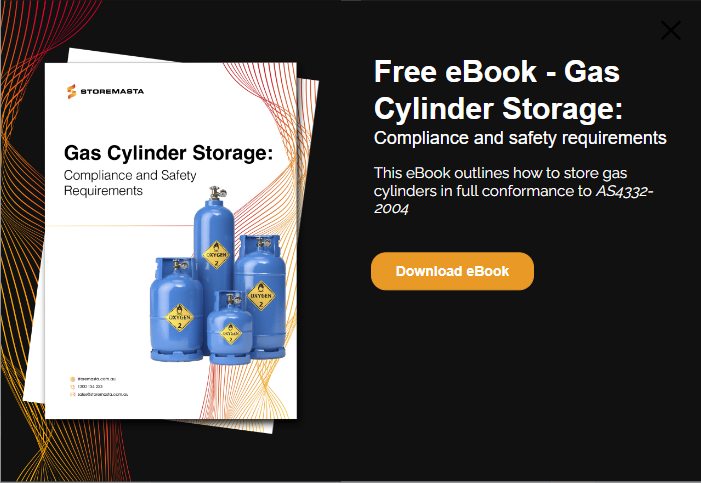You would probably know that gas is part of the four elements of life: air, water, fire and earth. However, if you’re reading this post, you probably also know that gas is something far more complex. If you’ve ever studied gases in chemistry or physics — or even within your workplace — you’ll be aware of just how technical they can get. But back on topic; what are Class 2 Dangerous Goods and how can they affect the safety of your workplace?
What are Gases?
Gases are considered as a state of matter. The three commonly known remaining states of matter include solids, liquid and plasma.
The term ‘gas’ extends to an extremely wide range of articles. Some of the more commonly known forms of gases can include compressed gases, dissolved gases, liquefied gases, refrigerated liquified gases, mixtures of gases and aerosol dispensers or similar vessels containing gas.
As defined by the Australian Code for the Transport of Dangerous Goods by Road & Rail (otherwise known as the ADG Code), a gas is:
A substance which at 50 degrees Celsius has a vapour pressure greater than 300kPa; or a substance which is completely gaseous at 20 degrees Celsius at a standard pressure of 101.3 kPa.
A gas can be defined by the kinetic monocular theory or rather, comparing its properties to those of liquid and solid forms. That is, a gas is a substance that does not have a fixed form or volume itself, is relatively compressible and has a relatively low density.
Permanent vs Non Permanent Gas
So, what is a permanent or non-permanent gas?
Permanent gases are recognised as gases that are incapable of liquefaction. These gases remain gaseuous under normal conditions, particularly normal temperatures. Examples of a permanent gas include carbon monoxide, hydrogen, nitrogen and oxygen.
On the other hand, non-permanent gases are capable of liquefaction. Non-permanent gas examples include carbon dioxide, chlorine, propane and nitrous oxide.
How the Gas and Liquefied Gases are Classified
While the ADG Code details the requirements for transporting dangerous goods, the Australian Standard AS 4332 provides the requirements for the handling and storing of gases in cylinders.
As per the classifications of gases in the ADG Code, these gases may include those that are:
- Compressed
- Liquefied
- Dissolved under pressure
Gases may also include chemical products including:
- Refrigerated liquefied gases
- Mixtures of one or more gases with vapours or liquids of substances of other classes
- Articles charged with a gas and aerosols having a capacity of greater than 1 L
Class 2 Gases
Dangerous goods are classified in the ADG Code to ensure that safe practices are conducted to reduce the hazards associated with each dangerous goods class.
As per the ADG Code, gases are classified in the following divisions:
Class 2: Gases
- Division 2.1: Flammable gases
- Division 2.2: Non-flammable, non-toxic gases
- Division 2.3: Toxic gases
REMEMBER: To identify gases numbered Division 1, 2 and 3, refer to the chemical’s safety data sheet (SDS). See Sections 2 and 14 to determine the key hazards and dangerous goods division of your Class 2 gases.
Basic Classification of Class 2 Gases
There would have to be thousands, if not more ways to break down the classification and definition of a gas, or in this case more pointedly, a compressed gas.
Understanding the class of gases present in your workplace is essential for ensuring safe storage and handling.
But even the term compressed gas covers a whole range of products, specifically seeing that it’s in general, a generic term used to describe not only compressed gases (non-liquefied gases), but liquified compressed gases, cryogenic gases, and dissolved gases.
In the next section of our post, we’ll detail some of the properties associated with these gas types:
Liquified Compressed Gases
Liquified gases are further classified into refrigerated and non-refrigerated liquified compressed gases, or otherwise, liquified and cryogenic gases. Liquified compressed gases are pressurised at normal temperatures to become a liquid. The cylinder is initially filled with the condensed gaseous substance in liquid form.
The liquid will naturally evaporate within the cylinder, creating a vessel filled to a liquid-vapour state of equilibrium. As gas is released from the cylinder, liquid will evaporate to fill the space that has been vacated, keeping the pressure within the cylinder constant. As more gas is released from the cylinder, the ratio of liquid to gas within the bottle will decrease. Examples can include anhydrous ammonia, methane, carbon dioxide, chlorine, and propane.
Cryogenic Compressed Gases
Cryogenic gases, or comparatively put; refrigerated liquified gases, are liquefied compressed gases that have been cooled, rather than compressed, to form a liquid state within a vessel. Cryogenic gases can be further classified into three categories: flammable gases, inert gases and oxygen.
All cryogenic gases have very low boiling points (-150’ C), and hence need to be kept very cold. Without the suitable temperature and pressure conditions, cryogenic gases may become liquids and present hazards. Possibly the most significant feature of cryogenic gases is the ability for small amounts of the gas to expand rapidly into extreme volumes of gas.

Cryogenic compressed gases, such as nitrogen, must be kept very cold.
Non-Liquified Compressed Gases
Non-liquefied gases can be known as real ‘compressed gases’ or sometimes permanent or pressurised gases. Non-liquified gases do not form liquids at normal temperatures when compressed, even when under high pressure. Examples can include argon, oxygen, helium and nitrogen.
Dissolved Compressed Gases
The only commonly used dissolved gas is acetylene. Chemically, acetylene is extremely unstable. To counter for this, acetylene is stored in a cylinder that is filled with a solvent (generally acetone) saturated porous.
The gas dissolves in the acetone, stabilising the substance. This allows the gas to be relatively safe for storage and handling.
The Basic Chemistry Behind Gases
The first basic knowledge of a gas generally begins with the comparison between gases, liquids and solids. This fades into the kinetic molecular theory of gases, which explains their behaviour, including that gases have no fixed volume, size or shape largely due to the lack of intermolecular forces. The same lack of bonding explains why gases are not dense and mix well with other gases.
At some stage you would have learned of the atomic theory of matter, including the subatomic structure of atoms; particles, protons, neutrons and electrons, and eventually the wonders of photons.
Thanks to years of study on gases, we understand a significant amount about gases and their behaviour. But who knows how much is as yet, left undiscovered?
Through the years, a number of gas laws have been established and can be used for the greater understanding in the behaviour of gases. Some of the more common gas laws can include Boyle’s, Charles’, Gay-Lussac’s and Avogadro’s laws. The Ideal gas law describes the general behaviour of most gases, and Van der Waal’s ‘real gas law’ accounts for those gases that won’t behave theoretically.
The ideal gas law equation is as follows: PV = nRT
Let’s have a quick look at those constants: P demonstrates pressure, measured in kPa or atm; V equals volume, measured in L, n is the number of moles, R is a gas constant, which changes depending on weather the pressure is measured in atm or kPa, and T represents temperature, given in Kelvin (K.)
Why Class 2 Gases Shouldn’t Be Heated, Pierced or Punctured
Mathematically, if one side of the equation increases, so will the other. The same will apply should one side of the equation decrease. so, if the temperature is increased, either pressure, volume, or a combination of both, will increase.

Take precautions to isolate gas cylinders from heat, as well as reducing the opportunity for impact damage.
It's easily seen then, that should a compressed (already highly pressurised gas) within a cylinder (having a fixed volume) can become dangerous as temperature increases. Should the temperature increase too significantly, such as in the event of a fire, the cylinder will not be able to contain the substance and is likely to rupture or explode ultimately adding to the fire and creating a flying projectile.
The same principle applies when a cylinder is pierced or punctured. The pressure within the cylinder will rapidly disperse from the weakened vessel, creating a flying missile.
Storage Requirements of Class 2 Gases
Being aware of how dangerous gases can potentially be, it’s critical that gas cylinders are stored in an appropriate manner. Gas cylinders in the workplace should adhere to the requirements of AS 4332 - The storage and handling of gases in cylinders.
It’s crucial, especially for cylinders containing pressurised gases, to be both used and stored only in an upright position, and when in storage the protector cap must be secured over the valve, and the cylinders secured with a strap, cable or non-abrasive coated chain that will not scratch the cylinder. Ideally, the cylinder should be stored in a customised racking system.
A gas cylinder store complaint to the Australian standards is specifically designed to cater for the risks associated with gases, and to reduce those risks in your workplace.
Storemasta gas cylinder cages are constructed to meet the requirements of the Australian Standards.
AS 4332 outlines a range of requirements of gas cylinder stores including:
- Gas cylinder stores must be constructed from non-combustible material
- The base of the gas cylinder store must be level. If drainage is required, the floor must be sloped in a way that doesn’t compromise cylinder stability.
- Any space between the bases of the gas cylinder store and the ground must be filled with a solid non-combustible material or have at least 2 ends completely open to the air.
- Any gas cylinder store that is attached to or located within a building must be separated from the rest of the building by one or more walls. Each of the walls must have a fire-resistance level (FRL) of 240/240/240.
- The floor above any gas cylinder store in a multistorey building must be constructed of a material having a fire resistance rating of 180/180/180.
- The walls and roof of gas cylinder stores must be of a non-combustible material. Where practical the supporting structure must also be of non-combustible material.
- Bollards and crash barriers must be installed where there is a risk of cylinders being damaged by vehicles in the surrounding area.
- Ignition sources must be excluded from any gas cylinder store containing flammable gases.
- The doors of a gas cylinder stores must open outwards or be a ventilated roller door that can be open from inside the store.
- Gas cylinder stores must also have gas cylinder restraint bars and chains to prevent the gas bottles from falling over.
- Gas cylinder stores must have sufficient natural or mechanical ventilation.
Safety Tips for Carbon Dioxide, Flammable Gases, Oxygen and More
So, who knew there was so much to a single element of life? Gases surround every moment of our lives. However, gases in cylinders are dangerous, almost inconspicuously so. If you’re working with Class 2 gases or any type of dangerous goods, keep in mind that they all present risk and danger within your environment. If you’re interested in finding out more information on gas safety, download our free eBook. We’ll help you understand the hazards of Class 2 gases and how you can control risk through some simple handling and storage safety measures.
Joining the team as a Dangerous Goods Storage Consultant, Melissa Hampton became Storemasta's Marketing Manager in late 2021. With extensive knowledge and experience in chemical compliance, Melissa is responsible for leading the Marketing team and helping shape their marketing strategy. In her spare time, you can find Melissa hiking, swimming and enjoying the great outdoors in beautiful north-west Tasmania.


